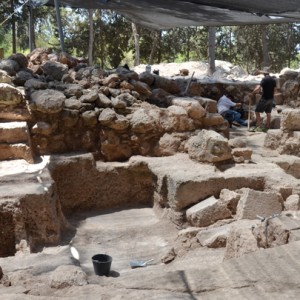×


We have detected your country as:
Please click here to go to the USA website or select another country from the dropdown list.

An impressive marble statue of a ram was uncovered near an ancient church that dates to the Byzantine period. The discovery was made in an archaeological excavation conducted by the Israel Antiquities Authority (IAA) in the Caesarea Harbor National Park. In Christian art, the ram is often depicted carried on the shoulders of the “Good
Continue Reading »A joint study by researchers of the Weizmann Institute and the Israel Antiquities Authority (IAA) examined fava seeds (broad beans) found in archaeological excavations in recent years at Neolithic sites in the Galilee in northern Israel. Seeds found at the prehistoric sites show that the inhabitants’ diet at the time consisted mainly of fava beans,
Continue Reading »The Israel Antiquities Authority (IAA) revealed for the first time another hidden treasure located in the city of Lod: a breathtaking Roman-era mosaic dating back nearly 2,000 years. The archaeological find was uncovered by chance during the construction of the visitor center for the famous “Lod Mosaic,” believed to have served as the living room
Continue Reading »Some years back, the ruler of a superpower set up headquarters in Jerusalem. Near the Temple courts he constructed a massive fortress. From its ramparts, he held Jewish rebels at bay, launching spears and slinging metal slugs emblazoned with symbols and inscriptions representing favorite deities. Determined to convert the Jews, and if not to squash
Continue Reading »
Fava seeds found at site A joint study by researchers of the Weizmann Institute and the Israel Antiquities Authority (IAA) examined fava seeds (broad beans) found in archaeological excavations in recent years at Neolithic sites in the Galilee in northern Israel. Seeds found at the prehistoric sites show that the inhabitants’ diet at the time
Continue Reading »
Some years back, the ruler of a superpower set up headquarters in Jerusalem. Near the Temple courts he constructed a massive fortress. From its ramparts, he held Jewish rebels at bay, launching spears and slinging metal slugs emblazoned with symbols and inscriptions representing favorite deities. Determined to convert the Jews, and if not to squash
Continue Reading »
A 1500-year-old mosaic, depicting a map with streets and buildings, was discovered in Kiryat Gat by the Israel Antiquities Authority (IAA). Buildings shown on the mosaic floors are a rare phenomenon in Israel. These are arranged along a main colonnaded street of a city, in a sort of ancient map. A Greek inscription indicates that
Continue Reading »
The Israel Antiquities Authority (IAA), together with local residents, has been conducting an unusual archaeological excavation in search of the real location of the Tomb of the Maccabees (Tomb). The Maccabees, from the ancient city of Modi’in, led the uprising against Greek rule and were responsible for cleansing the impurity from the Second Temple. The
Continue Reading »
An intriguing find consisting of an impressive pyramid-shaped staircase constructed of large ashlar stones was uncovered in an archaeological excavation currently conducted by the Israel Antiquities Authority (IAA). The excavation is located in the City of David, site of ancient Jerusalem. This structure, situated alongside the 2,000-year-old Second Temple stepped street, carried pilgrims on their
Continue Reading »
A piece of the burnt scroll Advanced technologies have made it possible to read parts of a scroll that was completely burnt c. 1,500 [years ago], inside the Holy Ark of the synagogue at Ein Gedi. The parchment scroll was unearthed in 1970 in archaeological excavations headed by the late Dr. Dan Barag and Dr.
Continue Reading »All logos and trademarks in this site are property of their respective owner. All other materials are property of Bridges for Peace. Copyright © 2025.
Website Site Design by J-Town Internet Services Ltd. - Based in Jerusalem and Serving the World.